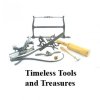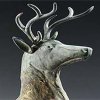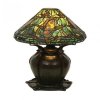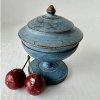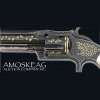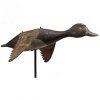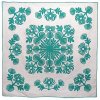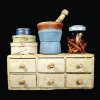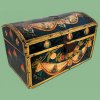The Parker Sale
January 19th, 2017
Sotheby’s, New York City
Photos courtesy Sotheby’s
On January 19 at Sotheby’s sale of the collection of the late George S. Parker II, a “very fine and rare William and Mary walnut chest of drawers” made in Pennsylvania sold in the salesroom for $32,500 (with buyer’s premium) to Delaware dealer James Kilvington. That chest of drawers last sold in 1990 at the landmark sale of the May and Howard Joynt collection at Christie’s for $38,500. Kilvington bought the chest for his client, a collector sitting next to him.

Philadelphia William and Mary walnut chest of drawers, made by John Head, 1718-26, with its original cast brass English hardware, 40" x 39½" x 21½", sold for $32,500 (est. $8000/12,000) to Delaware dealer Jim Kilvington. Jay Stiefel identified the brass escutcheon on this chest as identical to that illustrated in Adam Bowett’s Early Georgian Furniture: 1715-1740 (2009), p. 304, fig. 28. It sold at the Joynt sale at Christie’s in January 1990 for $38,500.
Both dealer and client expected fierce competition because conservator Chris Storb, in his blog In Proportion to the Trouble, had written about the chest before the sale, alerting those insiders in the world of American furniture that it was made by John Head, a fact that Sotheby’s had not mentioned in the sale catalog. Storb also pointed out its remarkable state of preservation, its original brass drop pulls and escutcheons, and its turned feet at full height, and noted that there was very little wear on the drawer runners. It is truly a miraculous survivor, the best preserved of all Head chests. Most chests of this period have lost their feet or suffered neglect when they fell out of fashion. This one seemed to have hardly been used; even Head’s chalk markings were pristine.
Storb knows a Head chest when he sees one. He and conservator Alan Andersen described Head to a scholarly audience at the 2014 Winterthur Furniture Forum when they analyzed materials, tool use, and construction and design, and identified Head’s chalk markings, all evident on this chest.
 John Head, mentioned as a joiner in Hornor’s Blue Book: Philadelphia Furniture (1935),was first identified as a major Philadelphia cabinetmaker by Jay Stiefel, a Philadelphia lawyer who discovered Head’s vellum-covered account book while he was doing research at the library of the American Philosophical Society. The account book has 231 pages of densely written entries documenting Head’s daily transactions from 1718 to 1763. An English immigrant joiner, Head came to Philadelphia in September 1717 with his wife and four of what were to be 11 children. He worked in Philadelphia as a cabinetmaker until 1744 when at age 56 it appears he retired from that part of his business and continued as a successful merchant.
John Head, mentioned as a joiner in Hornor’s Blue Book: Philadelphia Furniture (1935),was first identified as a major Philadelphia cabinetmaker by Jay Stiefel, a Philadelphia lawyer who discovered Head’s vellum-covered account book while he was doing research at the library of the American Philosophical Society. The account book has 231 pages of densely written entries documenting Head’s daily transactions from 1718 to 1763. An English immigrant joiner, Head came to Philadelphia in September 1717 with his wife and four of what were to be 11 children. He worked in Philadelphia as a cabinetmaker until 1744 when at age 56 it appears he retired from that part of his business and continued as a successful merchant.
The account book and Stiefel’s interpretive essays have been available on the American Philosophical Society website since 2001, when they were published in its Library Bulletin. Later this year, in celebration of the tercentenary of Head’s arrival in Philadelphia, the American Philosophical Society will digitize the Head account book and make it available on its website and will publish a book by Jay Stiefel, bringing up to date all he has learned about Head in the last 16 years and illustrating the more than 60 pieces of furniture documented or attributed to John Head. The book should be available early in the fall. Institutions have already reserved 250 copies.
According to Stiefel, Head made 118 chests of drawers costing £3 each, and lots more, including 26 suites of high chests and dressing tables, 55 oval tables, 52 bedsteads, 91 clock cases, 19 cradles, five corner cupboards, 11 close stools, three clothes presses, and 73 coffins. Casper Wistar’s chest of drawers and dressing table were the first to be documented to Head and are illustrated in the 1999 catalog for the Philadelphia Museum of Art exhibition Worldly Goods. In 2008, Storb, Andersen, and Stiefel published an article on Head’s documented furniture, which included a third piece ordered by Wistar, a walnut tall-case clock with a William Stretch movement.
Since 1999, 66 objects by Head have been attributed, including high chests, dressing tables, chests-on-chests, chests of drawers, clock cases, a desk, an oval gate-leg table, and a spice chest. Of these only about half a dozen are chests of drawers, fewer than the number of attributed clock cases. Read Storb’s In Proportion to the Trouble blog to learn the fine points of Head’s shop practices. He illustrates his blog with first-rate photographs of the details of construction.
The chest came up early in the sale of the collection of the late George S. Parker II, the scholarly CEO of the Parker Pen Company, who died in 2004. In addition to American furniture, Parker collected English silver and American Colonial portraits, also offered at this sale. An art history major at Brown University, he had an interest in Classical archaeology, maps, and American paintings. After the John Carter Brown Library published his book The Mapping of the Great Lakes with full-size facsimiles of the earliest maps of the Great Lakes that could be used by students, he gave his map collection to Brown University. Parker also collected Modernist paintings. He especially liked The Eight, some of whom were also associated with the Ash Can school. Sotheby’s sold his paintings in the American paintings sale in October 2016. His collection of American furniture from the Pilgrim Century to the Federal period expressed the American experience.
Parker was not known to the New York collecting community. He rarely came east. Often he did not see what he bought until it was delivered to his Janesville, Wisconsin, house. From the 1980s until he died in 2004, he relied on Alan Miller, a conservator and furniture scholar from Quakertown, Pennsylvania, to bid and to buy for him. Before he met Miller, Parker bought from John Tompkins of Millbrook, New York, and John Walton of Jewett City, Connecticut. Miller is not a dealer. Sometimes he found furniture in dealers’ inventories, but most often he bought at auction, so price histories are available. Miller said Parker always placed art before condition and sought furniture that had a story to tell because he was putting together a study collection to be used as a teaching tool. He wanted to be able to understand the development of American furniture from the earliest works to the Federal period made from New England to the Middle States. He gave his collection to the University of Wisconsin through his Caxambas Foundation. The university used it for 20 years and then consigned it to Sotheby’s.
The Parker sale did well. Of the 256 lots offered, 220 sold for $5,035,104; that is 85.9% by lot. Advisors Luke Beckerdite and Alan Miller were major buyers, and dealers Skip Chalfant, Philip Bradley, and James Kilvington represented clients and also bought for stock. Some New England dealers were active in the salesroom, and the trade and private collectors competed in the salesroom, on phones, and online. Estimates were reasonable, reflecting today’s market and the fact that many pieces were restored.

Carved and figured mahogany block-and-shell kneehole bureau table, Providence, Rhode Island, circa 1765, with original brasses, 34½" x 37" x 18¼", sold for $672,500 (est. $300,000/500,000) to Luke Beckerdite for a client. It has a John Walton, David Stockwell, and collector Lansdell Christie provenance. It sold at Christie’s in January 1996 for $156,500. Did the recent exhibition of Rhode Island furniture and its accompanying catalog have an influence on the market for Rhode Island furniture?
Although Parker’s Rhode Island block-and-shell kneehole bureau table had been published as made in Newport, recent scholarship suggested that it was made in Providence, making it very rare. Luke Beckerdite bought it for $672,500 (est. $300,000/500,000), underbid on the phone. At the sale of the estate of Mrs. Lansdell Christie in January 1996 at Christie’s, it sold for $156,500. The Hollingsworth-Humphreys Philadelphia piecrust tilt-top tea table, circa 1770, sold to a collector on the phone for $636,500 (est. $150,000/250,000), underbid in the salesroom by Steve Smith, a discerning Pennsylvania collector.

The Hollingsworth-Humphreys family carved and figured piecrust tilt-top tea table, probably from the shop of Thomas Affleck, the carving attributed to John Pollard, Philadelphia, circa 1779, with an old rich surface, 29½" x 32¼" x 30¼", sold for $636,500 to a phone bidder, underbid in the salesroom by Pennsylvania collector Steve Smith. It sold at Christie’s in New York City in January 1995 for $398,500. Levi Hollingsworth bought it in August 1779 and paid for in part with seven gallons of spirits worth £52.10. It remained in the Hollingsworth family until it was bought by dealer David Stockwell of Wilmington, Delaware. His successor, Ron Bauman, advertised it in The Magazine Antiques in January 1990.
It is hard to explain why Charles Thomson’s mahogany armchair, with carving attributed to John Pollard, Philadelphia, circa 1770, did not sell. It had a rich old surface, and the restoration at the top of the stiles and splat and on the rear legs was masterful, but there was no bidding. The estimate was $200,000/300,000. At Christie’s in June 1993, it sold for $123,500 (est. $70,000/90,000). A side chair from the same set sold at Christie’s in January 1987 for $341,000, then a record for any American side chair.
New York City dealer Frank Levy said he was thrilled to get a rare New York mahogany games table with porringer corners, circa 1760, with its original cast brass hardware, for $9375 (est. $10,000/15,000). He said he had been the underbidder when it sold for $48,400 (est. $30,000/50,000) at Christie’s in June 1992. West Chester, Pennsylvania, dealer Skip Chalfant got a Boston turret-corner Queen Anne walnut games table, circa 1760, for $37,500 (est. $40,000/80,000). At Christie’s in October 1997, it sold for $74,000.
Some furniture brought more than in the past, and some brought less. The fact that collectors and the trade were willing to buy furniture with some restoration, much of it minor, such as replaced knee returns, extended legs, or replaced feet, demonstrates the strength of the market. The fact that there was bidding on more than 85% of the lots shows the breadth of the market, which hit bottom during the Great Recession, has now turned around, and is on the upswing. For more information, call Sotheby’s Americana department at (212) 606-7130 or check the website (www.sothebys.com).

Queen Anne carved walnut compass-seat side chair, Philadelphia, circa 1755, 42" high, proper left front foot partially replaced, seat rail and slip seat marked “I,” sold for $93,750 (est. $60,000/80,000) to Alan Miller in the salesroom. At Sotheby’s in June 1990, it sold for $38,500. It is a fully developed Philadelphia compass-seat chair, and the color of its surface has been improved.

Queen Anne shell-carved mahogany compass-seat side chair, attributed to John Goddard, Newport, Rhode Island, circa 1765, chair marked “VI,” slip seat marked “I,” the base of the proper right rear leg with a triangular patch, 38¼" high, sold on the phone for $50,000 (est. $20,000/30,000), underbid by Massachusetts dealer Gary Sullivan. In January 1995 at Christie’s, it sold for $9200 (est. $10,000/15,000).

Philadelphia rococo side chair, circa 1760, the slip seat marked “VII,” 40¼" high, with a Joseph Kindig and William du Pont provenance, sold for $150,000 to Alan Miller (est. $80,000/120,000). It is from a set that is the most elaborate of the strapwork type, with additional carving on the shoe extending from the knees up onto the corners of the seat frame. It has shells on the ears and a shell with pendant leafage on its crest.

This pair of carved Philadelphia side chairs, the carving attributed to Martin Jugiez, circa 1765, sold for $324,500 (est. $200,000/300,000) to Luke Beckerdite, underbid in the salesroom by Bradley C. Brooks, curator of Bayou Bend. This pair of chairs turned up at Stoudts Black Angus Antiques Mall, Adamstown, Pennsylvania, where they did not sell. Then in January 1977 they were consigned to Sotheby Parke Bernet where they were bought by David Stockwell for $27,000. At that time they were missing the moldings on the seat rails, and one had a patch to the gadrooning. They ended up with Bernard and S. Dean Levy, from whom they were bought by J. William Middendorf, who sold one back to Levy and consigned the other to Christie’s for a January 1991 sale. In 1991 at Christie’s, one of the pair (with the seat moldings and the patch to the gadrooning restored), sold for $71,500. This set of chairs is based on plate XIIII of Thomas Chippendale’s The Gentleman and Cabinet-Maker’s Director (London, 1754). Another pair from the set is at Winterthur, and another pair sold at Christie’s sale of the collection of May and Howard Joynt of Alexandria, Virginia, in January 1990 in two lots. They made $418,000 and $330,000, and the buyer was dealer Leigh Keno of New York City, who was bidding for a client.

This pair of portraits by Charles Willson Peale (1741-1827) of Mr. and Mrs. Thomas Russell, 1784, oil on canvas, each 30" x 25", sold for $75,000 (est. $30,000/50,000) to Jim Kilvington. At Sotheby’s in May 1995, they sold for $107,000 (est. $40,000/60,000). Thomas Russell, born in Birmingham, England in 1741, came to America in 1764, settling in Cecil County, Maryland, at North East Forge. Coming from a family of British ironmasters, he was a key figure in the iron industry in America, which was vitally important in the movement toward revolution and independence. He was one of the organizers of the Principio Iron Company along with Lawrence Washington and other prominent men who doubtless depended on his technical knowledge.

Carved mahogany fire screen, carving attributed to Martin Jugiez, Philadelphia, circa 1770, frame and finial replaced, 63¼" high, sold for $250,000 (est. $60,000/80,000) to Alan Miller. In January 1990 at the Joynt sale at Christie’s, it sold for $66,000.

Federal inlaid and figured mahogany bowfront server, attributed to William Hook, Salem, Massachusetts, circa 1810, 43" x 48" x 24½", sold to a collector on the phone for $37,500 (est. $6000/8000).
Originally published in the March 2017 issue of Maine Antique Digest. © 2017 Maine Antique Digest




